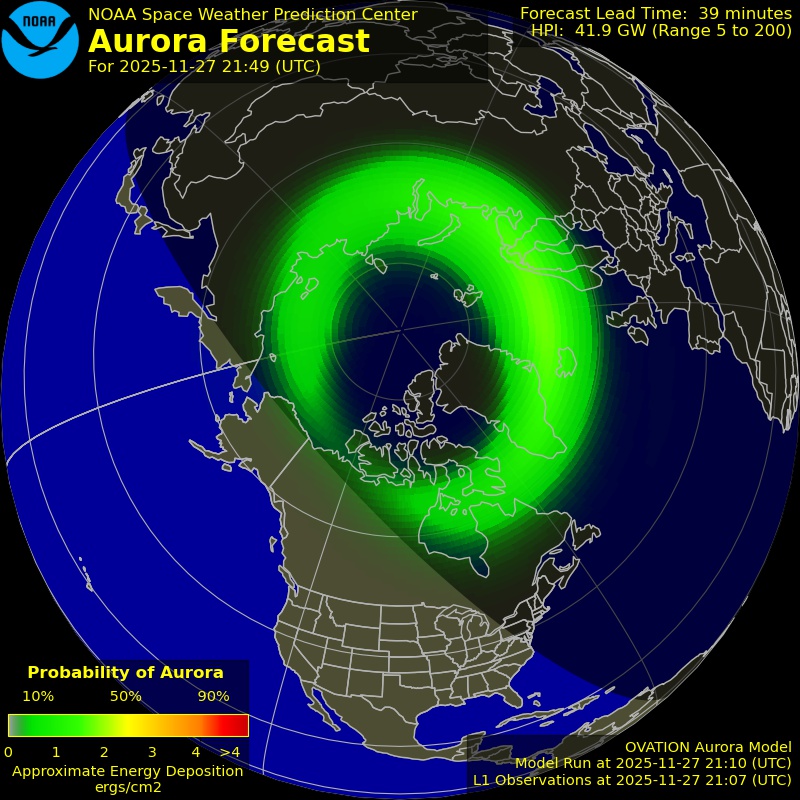Northern Lights Forecast for Fort McMurray
Substorm
Substorm Phase: Quiet; Aurora Activity Score: 15/100
Ideal Conditions for Northern Lights in Fort McMurray:
Power: +20 Gw | Bz: -1.5 | Wind Speed: 300+ | Density: 4+ | Kp: 3+
If the data above meets or exceeds the power meets then the aurora borealis should be visible within Fort McMurray.
Don’t Miss the Magic!
Stay ahead of the Northern Lights with real-time alerts. Subscribe now to receive a text or call whenever the aurora is active—so you never miss a moment of the show.
How to use this data:
Fort McMurray, located in Alberta, Canada, offers some excellent locations to view the Northern Lights (Aurora Borealis). To increase your chances of witnessing this mesmerizing natural phenomenon, consider the following.
Using our tool you can increase your chances of viewing the Aurora.
We take live satellite data and place it into an easy to read dashboard filtering the noise. But- this can all be confusing. Follow our “how to” for more information”
Use our long range forecast to plan a trip well in advance and nail it down with more local minute to minute insights.
Where to see the northern lights in Edmonton?
The Aurora Borealis can actually be seen within the city limits of Fort McMurray.
Here is some popular spots for photographing the Aurora Borealis in Fort McMurray:
- Raphael Cree Boat Launch: This is one of our favorite spots in Fort McMurray to photograph the Northern Lights. Recommended to us by some locals we tested out this location and it's one of our all time favorite spots! This spot is located in the Waterways location and has an access point to the clear water river.
- Gregoire Lake Provincial Park: Located about 30 kilometers south of Fort McMurray, Gregoire Lake Provincial Park offers a serene environment for aurora viewing. The park's tranquil waters and relatively dark skies provide an excellent backdrop for observing the dancing lights.
- Athabasca Riverfront Park: Situated along the Athabasca River, this park provides a picturesque setting for witnessing the Northern Lights. The river reflections can add an extra touch of magic to your aurora viewing experience.
- Tower Road – OHV Staging Area: Although we have never tried this location we hear many good things about this location from a number of other tour operators.
When can you see northern lights in Fort McMurray?
Usually after dark around 11:00 PM to 3 AM the next morning. On very strong nights the northern lights have been able to be seen much earlier.
We have see the lights form even during blue hour.
When is the best time of year to see the aurora borealis in Fort McMurray?
During January and February, Fort McMurray experiences two prime months for viewing the Northern Lights. However, with average low temperatures of -22°C and -21°C respectively, it's essential to be well-prepared to fully enjoy the spectacle. If you intend to witness the lights and perhaps even capture photographs, be sure to bundle up warmly, paying special attention to keeping your hands and toes cozy.
Can you see the northern lights in Fort McMurray tonight?
That depends on the data coming in. For best results keep an eye on Aurora Admin and track the data coming in. If the target criteria is met then there is a good change for aurora.
You will have a greater chance of seeing the Aurora Borealis is Fort McMurray then you would in a more southern city like Edmonton.
How long do the Northern Lights usually last?
The Northern lights in Fort McMurray only show for brief periods at a time, usually for only a few minutes then they die down for a bit. A good display may last for no longer than 15-30 minutes at a time, although if you’re really lucky, it could extend to a couple of hours or longer.
Tips for Aurora Viewing in Fort McMurray:
- Check Aurora Forecasts: Monitor real-time aurora forecasts and space weather predictions to plan your aurora-chasing excursions during peak activity times.
- Dark Skies and Clear Weather: Seek locations with minimal light pollution and clear skies for optimal aurora visibility.
- Be Patient: Aurora displays can be unpredictable, so be patient and give yourself enough time to witness the auroras.
- Dress Warmly: Fort McMurray's winters can be cold, so dress in warm layers to stay comfortable during your aurora viewing sessions.
- Safety First: When venturing out for aurora watching, prioritize your safety and avoid hazardous areas or activities.
Aurora Oval
Northern Hemisphere

